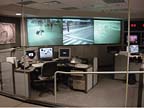
Eppley is owned and managed by the Omaha Airport Authority (OAA). After a distinguished career in the U.S. Air Force, Ralph Holtmann came to the OAA in 1989. Holtmann’s wide ranging responsibilities included the OAA’s security programs. In 1990, Federal Aviation Administration (FAA) regulations sent Holtmann in search of technology solutions that would enable the OAA to comply with these new security regulations.
His search would lead him to Omaha’s Security Equipment Inc. (SEI). After evaluating the limited number of electronic access control systems available at the time, Holtmann gave Tom Hruby, then security engineer and now executive vice president of SEI, the approval to begin installation of a UNIX-based access system that used magnetic stripe cards. While much of the rest of the airport was updated over the years, Holtmann managed to get by with the system with help from SEI. That was before September 11.
“9/11 forced us to rethink and look at what we were doing,� Holtmann said. “We knew we had to radically increase our ability to monitor the airport.�
Holtmann came to the conclusion that he could no longer meet the OAA’s security needs with the current system. Consequently, Holtmann and his team prepared a new system bid request to be sent to security system integrators in the area.
The bid request contained a number of features that would enable Holtmann to deliver the level of security the Airport Consultants Council recommended. First, the new access control system had to be able to integrate CCTV and intrusion monitoring into a single interface for real-time visual monitoring of access control events.
Second, the access control system had to be able to expand to meet the OAA’s current and future monitoring requirements. “The new system would double the number of card readers – to a total of 240 – and radically expand the CCTV system to a total of 135 cameras,� Hruby said. Most importantly, the new access control system had to be available at all times. It could not fail – ever.
In SEI’s response to Holtmann’s bid request, Hruby recommended AMAG Technology, Torrance, Calif.
“Most importantly, AMAG offered a proven solution to the system availability requirement through its hot redundancy option,� Hruby said. AMAG’s hot redundancy capability is supported by Microsoft’s clustering technology that links individual servers together. If the active server in the cluster fails, the system automatically shifts its operation to the passive server in the cluster.
SEI replaced the existing equipment with AMAG S690 proximity readers, AMAG M2100 16-door controllers, and installed the AMAG Enterprise access control software in the OAA’s communication center. Additionally, SEI installed Kalatel CCTV cameras, matrix switchers, and digital video recorders (DVRs). Using AMAG’s built-in CCTV integration capabilities, SEI was able to provide the OAA with a synchronized access control and CCTV monitoring interface.
The access control and CCTV systems operate over the OAA’s new fiber optic network. “Frequent thunder storms create electromagnetic fields (EMFs) that disrupted our previous copper wire network,� Holtmann said. The fiber network is not susceptible to EMFs, requires less maintenance, and offers faster data transfer rates over greater distances.
“Now, our security systems are on par with those installed at the nation’s largest airports,� Holtmann said.


